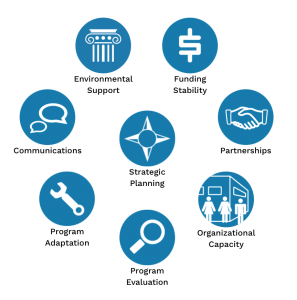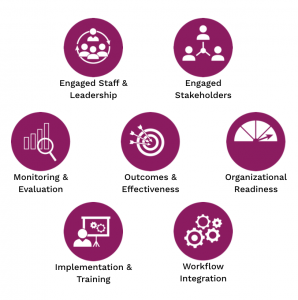Module 4: Building Sustainable Online Programs
Creating a Sustainability Plan
Denise Stockley
In the first two units of this module, you’ve explored the importance of creating a sustainability plan, approaching sustainability through the interconnected ecosystem of online programs by using a systems approach, and embedding sustainability planning from Day 1 of your program planning. You’ve also begun to identify elements and collaborators that will play an important role in developing your sustainability plan and reflect on how ready your institution or program is to begin the sustainability planning process. If you have completed this work, you’re ready to develop your sustainability plan. This unit provides you with practical steps and tools to undertake that task.
Learning Outcomes
By the end of this unit, you will be able to:
- Revisit your online program vision with a sustainability lens
- Create or review a sustainability plan for your institution
You will take away:
- A sustainability plan that is both actionable and renewable
Creating a Sustainability Vision
As we explored in detail in Unit 2 of this Module, taking a systems approach to sustainability and ensuring institutional readiness sets the foundation to create your sustainability plan. Like other institutional plans, a sustainability plan should be actionable and measurable – a living document rather than something filed away and brought out every few years.
It’s important to recognize that each online program measures success differently because there are many internal and external drivers that determine what it means to be sustainable. For example, your program’s success may be based on not only achieving one or more of the following program or institutional goals, but also their ability to sustain and/or continuously improve them once they are achieved:
- Increased enrolment and successful graduation of students from equity-deserving groups, and the development of any associated new resources or policies that support this;
- Ability to attract faculty, external funding, etc.;
- New partnerships or collaborations with other institutions;
- Increased joint faculty-student research projects;
- Innovative curricula;
- Increased student engagement with and positive impact in their local communities
- The successful introduction and use of new eLearning tools
- More efficient enrolment process that reduces staff hours on this task
- Increased engagement in and reported student satisfaction with the quality of their online courses
These drivers could be limitless, but it is critical to identify the attributes that matter the most to the program, institution, and its stakeholders so that you can determine which metrics and data collection procedures will enable you to know whether the program achieved its goals and can sustain them. Unlike provincially mandated quality assurance processes used in course design, each institution should create its own sustainability plan that takes into account their institutional context (e.g., Strategic Mandate Agreements with the Ministry of Colleges and Universities, Strategic Plans, Program Vision and Goal). Each of these areas will make up a component of your blueprint for sustainability.
The good news is that a lot of this work happens when you assess your program development readiness, create and align your program vision (e.g., the “why” for your program”), assess your program feasibility and seek program approval, and then start visioning your program’s curriculum. The step that you should introduce into all of these actions in relation to sustainability is to ask, “how will we sustain this work over the next 5 years and beyond?”
The Program Development and Implementation Workbook activity below prompts you to start reaching some consensus around what “success” and “sustainability” look like in your program before you begin the work of building a plan. If you completed Unit 1 and Unit 2 in this module, you will have already begun identifying how each element of the online ecosystem interacts with your vision and goals for the program and what might be required to sustain them, as well as possible collaborators and what data you might collect. This next step will help you find “common ground” in prioritizing a vision for sustainability in your program and identifying where your priorities for sustainability lie.
Workbook Activity: Create a Sustainability Vision
Complete the following Sustainability Visioning table in the Workbook to create a shared vision of sustainability.
| Response | |
| Sustainable programs in our institution/department share the following qualities: | |
| Essential elements of online programs at my institution/department include . . . | |
| Essential elements of our program that need to be sustainable are. . . |
Develop Your Sustainability Plan
Revisiting Institutional and Program Readiness for Sustainability
In Unit 2 of this module, we asked you to consider your institutional or program readiness. Before moving on to developing your plan, we recommend that you complete this work. Why? Because even the best sustainability plans can fail if the will or resources to implement them are not present. For that reason, we’re diving a bit deeper into assessing institutional or program readiness by highlighting a useful assessment tool.
Colleagues at Washington University, St Louis MO have created two freely available tools that assess capacity for sustainability depending on whether you have an academic or clinical program: The Program Sustainability Assessment Tool (PSAT) and Clinical Sustainability Assessment Tool (CSAT). As you can see in Figure 1, each tool focuses on several key areas or “organizational or contextual domains” necessary to support implementing a sustainability plan. You can read more about each area by visiting Understand Program Sustainability and Understand Clinical Sustainability.
Program Sustainability Assessment Tool (PSAT) |
Clinical Sustainability Assessment Tool (CSAT) |
 |
 |
Workbook Activity:
Select one of the two sustainability frameworks outlined above that is most appropriate for your context. Complete the sustainability assessment tool for the associated framework:
PSAT:https://sustaintool.org/wp-content/uploads/2016/12/Sustainability-ToolV2_w-scoring_12.11.13.pdf
CSAT:https://sustaintool.org/wp-content/uploads/2020/01/CSAT-tool-and-scoring_1.14.20.pdf
Developing the Sustainability Plan
The final step in sustainability planning is to develop your plan. We’re turning again to our colleagues at Washington University for inspiration and tools. They have helpfully shared example completed sustainability plans in both the program and clinical areas of focus as well as their templates for developing them.
Using the Program Sustainability Template plan as an example, we can see how the work you’ve undertaken so far across this module ties into creating the plan itself. The plan begins with documenting the following information in to guide the plan:
Program Vision Statement: [Describe the final long-term goal or vision of your program or initiative.]
Background: [Briefly summarize the history and current state of the program you wish to sustain.]
Current Funding Sources: [List the current funding sources for this program along with their expiration dates.]
Sustainability Results: [Summarize your program’s strengths and areas for improvement identified in your results from the Program Sustainability Assessment Tool.]
Program Elements to be Sustained: [List the program elements that your team has decided to sustain. Refer to your evaluation data to see which program elements are most effective and essential.]
Partners: [List partners involved in the sustainability assessment and/or creation and implementation of the sustainability plan.]
Time Frame: [Enter the period over which the sustainability activities listed below will be implemented.]
The tool then moves on to having you create and plan, measure, and decided which resources will be necessary to sustain the program in relation to these questions in the key areas you identified using the Program Sustainability Assessment Tool above.
Here is an example sustainability plan created using the template.
Workbook Activity:
Use Washington University’s Sustainability Action Planning Template to create your program sustainability plan. We’ve included the Program Planning Template in the Program Development and Implementation Workbook for your convenience, but you can also access it and example plans at https://www.sustaintool.org/psat/plan-for-sustainability/#develop-an-action-plan. The template has a Creative Commons BY-NC-SA license, so you can share and modify it as needed for non-commercial purposes.
If you find the Clinical Sustainability approach more relevant to your program you can access those planning tools here: https://www.sustaintool.org/csat/develop-your-plan/#develop-an-action-plan.
For either template:
- Fill out the outline section first to capture the Program Vision Statement, Background, Current Funding Sources, Sustainability Results, Program Elements to be Sustained, Partners, and Time Frame.
- Then, complete the tables that follow to develop your sustainability plan. These tables cover the areas for consideration outlined in the Program or Clinical Assessment Tools list above, respectively.
Unit Reflection and Resources
Now that you have completed your sustainability plan, it’s essential that you put it into action: A plan isn’t useful until it is put in motion. Reflect on any obstacles you can foresee to putting this plan into action. What steps can you take to proactively overcome these obstacles?
Unit Resources
- Module 4 Video Playlist
- Washington University’s Sustainatool Website
